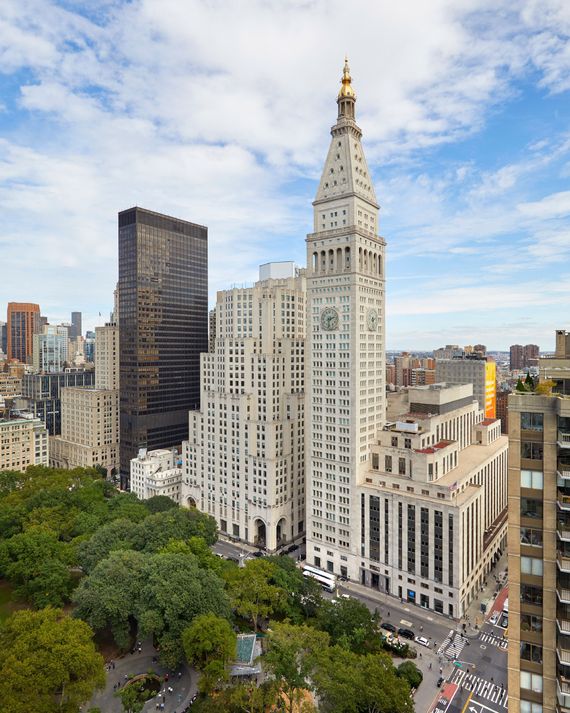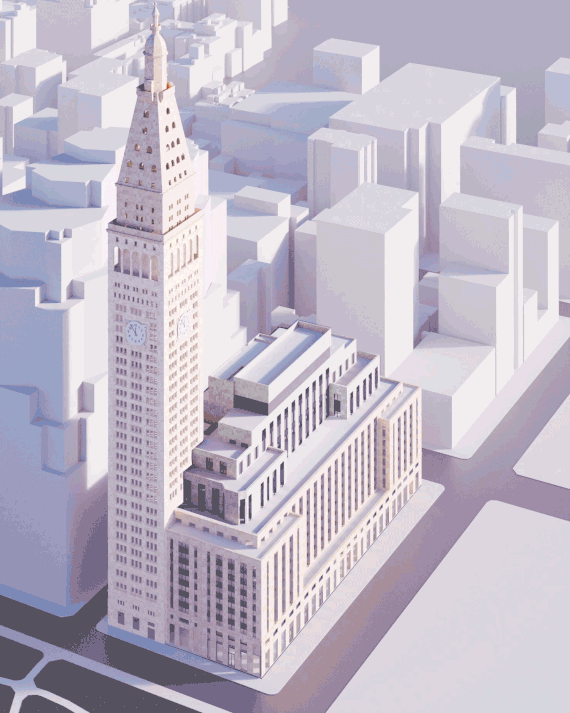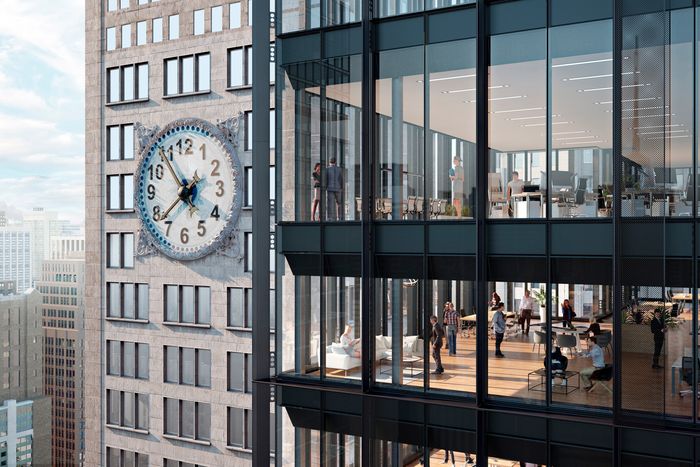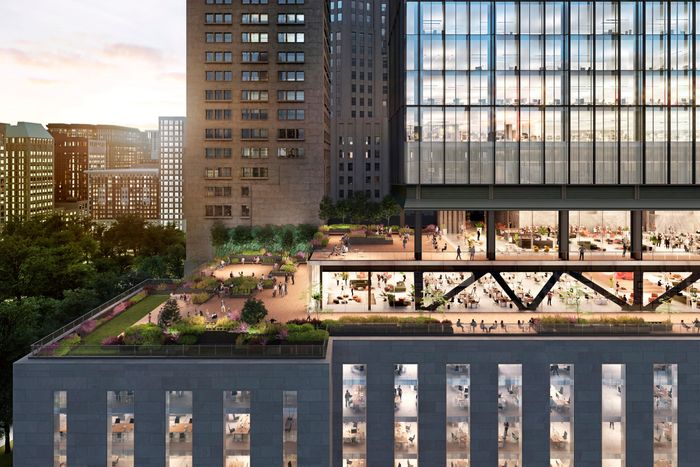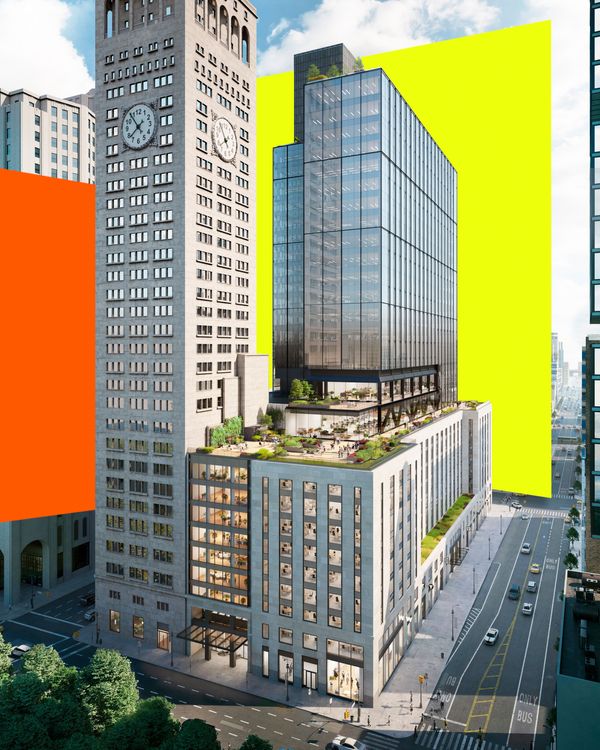
View of the addition of a glass office tower designed by Kohn Pedersen Fox Associates at One Madison Avenue.
photo illustration: curb; Photo: Motif
Where is New York City Center located? Some would say the city center due to its status as a bargaining centre. Downtown, at least culturally, would be argued by others. But just over 100 years ago, a New Yorker would have said Madison Square Park. As novelist Willa Cather wrote of the area in 1915, “Madison Square was then at the crossroads; (it is) a dual character, half commercial and half social, with shops to the south and dwellings to the north.”
Today, the park is still surrounded by buildings that define New York’s economic and cultural history. The Flatiron Building, barricaded between Broadway and Fifth Avenue, is home until 2019 to Macmillan Publishers and is now empty and was recently repurchased by a consortium of its current owners at an auction in May. The four Corinthian columns in the Court of Appeals on Madison Avenue are thicker than the oldest trees in the park. The original Madison Square Garden was once located north of today’s Madison Square Park. But the building that towers over them all (literally) is the Metropolitan Life Insurance Company tower, also known as One Madison Avenue – not to be confused with the MetLife Building That looms over Grand Central or One Madison, a new luxury apartment building one block south developed by Related. With a single oversized clock on each facade and a spire inspired by Grace Saint Mark In Venice, the Met Life tower has dominated the corner of East 24th Street for more than a century. Completed in 1909, it was for a few years the tallest building in the world, though now it is, of course, one of the more rigid silhouettes of the city’s skyline.
The building before the office addition.
Photo: Kevin Chu Jessica Paul
Most passers-by barely register the mid-century building’s unassuming east wing, a 150-foot-tall structure that clusters in the shadow of its 700-foot counterpart. But soon, the glass-encased addition, which is due for completion this year, will nearly double its height. Kohn Pedersen Fox Associates stacks 13 floors of offices, gyms, and a restaurant atop the steel skeleton of the 14-story East Wing. It’s a great office bet at a time when the post-COVID commercial real estate market in Manhattan is looking bleak. But developers SL Green and Hines, along with the National Pension Service of Korea, have nearly filled the building 1.3 million square feet with tenants. The main tenant, IBM, which includes floors eight through ten and part of levels seven and two, will be joined by two investment firms and a three-story gym from Chelsea Piers Fitness. On the dining side, Chef Daniel Boulud takes over 16,000 square feet for very little space. mini market and a steakhouse. Boulud will also manage a 7,000-square-foot lounge for tenants on the roof of the original building. At the top of the new structure, the indoor event space will be divided into a landscaped courtyard with views of Madison Square Park. The main tower was converted in 2015 into New York editionluxury hotel.
In a city that is almost entirely built up, putting new buildings on top of old is a time-honored development strategy. Last year, investor Jeff Green He fell 18 floors of apartments atop a six-story building in Hudson Square. Development company Two Trees is building a glass-domed, barrel-domed office Penthouse which will rise above the roof of the former Domino’s sugar refinery in Williamsburg. Three miles south, in downtown Brooklyn, the JDS Development Group has grafted a 1,066-foot skyscraper onto the historic Dime Savings Bank Building. On the smaller end of the height spectrum is the Cadence real estate group added Two stories, 30 apartments to a working post office in Hell’s Kitchen.
Time-lapse illustration of the new 13-story office wing at One Madison Avenue elevated on the old east wing.
Graphic: KPF
However, the building atop the building was not the primary focus of SL Green’s original plan for One Madison Avenue. When she bought the complex in 2005 from MetLife, she wanted to convert the Clock Tower building into apartments and rent the shorter east wing as offices. Ownership interests in the property have changed hands several times, with Marriott converting the tower into a luxury hotel in 2012. Six years later, SL Green announced that it had chosen KPF as the architect of the expansion for the east wing. The development team avoided reconfiguring the main tower – it is a landmark – and instead extracted air rights from surrounding properties to achieve the required height and mass for the addition, a move that would allow for a taller building without having to obtain further approvals to gain additional height.
Although the new and old building are different at first glance, they are connected both mechanically and physically. KPF drove massive columns into the mid-century structure’s battered base to support the addition, and carved a mechanical umbilical cord inside the new building that connects the iconic tower’s heating and cooling systems to the new building, project architect Amy Savage explained. This extensive system is tucked under the structural steel construction in the new tower, just below the truss on the tenth floor balcony. While the glass face of the addition is the most prominent, a closer look reveals limestone details similar to the historic tower. In fact, they’re identical: KPF sourced Alabama limestone from the same quarry.
A view of the offices rising next to the iconic tower.
Graphic: Motif
A dedicated deck for tenants on the roof of the original building.
Photo: Motif
Besides the common stone grit and face, the new and old buildings tell two stories about the evolution of corporate architecture in New York. When Metropolitan Life Insurance hired Napoleon LeBrun & Sons to design its entire 11-story home office in the 1890s, it was one of the first companies to be headquartered uptown (mostly clustered downtown in what is now in the name of Financial Disbursement). Just over a decade later, she commissioned the same architect to create the tower using the four clocks. The company didn’t necessarily need the space; He wanted a memorial. The new building expected stability and security, two essential qualities for an insurance company in an industry that was at the time plagued by scams and failures. The lantern at the top of the tower is nicknamed “The light that never failsIt was featured prominently in Met Life advertisements several decades after the building was completed.
The tower was also one of the city’s first contenders in the skyscraper height wars; It beat out the (now demolished) headquarters of the Singer Sewing Machine Company in lower Manhattan, which was the tallest building in the world. The construction of the tallest skyscraper has given Met Life its cache.
Compared to its flashy predecessor, One Madison Avenue is more introverted. Although the ground floor restaurants are open to all, its distinguishing features – the two terraces and buttresses of the tenth floor – are not visible from the street. Glass fronts allow a peek into the desks, but ironically, given the screen-based nature of contemporary office work, it is unclear to outsiders what exactly is being produced inside. The 20th century office building was a corporate branding exercise, but the 21st century office stands out for its interior design.
“We weren’t trying to develop a landmark,” Savage said. “I think we were kind of doing the opposite. We wanted to focus on the tower.”

